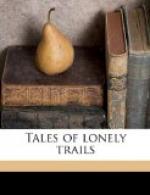CHAPTER II
COLORADO TRAILS
Riding and tramping trails would lose half their charm if the motive were only to hunt and to fish. It seems fair to warn the reader who longs to embark upon a bloody game hunt or a chronicle of fishing records that this is not that kind of story. But it will be one for those who love horses and dogs, the long winding dim trails, the wild flowers and the dark still woods, the fragrance of spruce and the smell of camp-fire smoke. And as well for those who love to angle in brown lakes or rushing brooks or chase after the baying hounds or stalk the stag on his lonely heights.
[Illustration: Pack horses on A sage slope in Colorado]
We left Denver on August twenty-second over the Moffet road and had a long wonderful ride through the mountains. The Rockies have a sweep, a limitless sweep, majestic and grand. For many miles we crossed no streams, and climbed and wound up barren slopes. Once across the divide, however, we descended into a country of black forests and green valleys. Yampa, a little hamlet with a past prosperity, lay in the wide valley of the Bear River. It was picturesque but idle, and a better name for it would have been Sleepy Hollow. The main and only street was very wide and dusty, bordered by old board walks and vacant stores. It seemed a deserted street of a deserted village. Teague, the guide, lived there. He assured me it was not quite as lively a place as in the early days when it was a stage center for an old and rich mining section. We stayed there at the one hotel for a whole day, most of which I spent sitting on the board walk. Whenever I chanced to look down the wide street it seemed always the same—deserted. But Yampa had the charm of being old and forgotten, and for that reason I would like to live there a while.
[Illustration: The grassy Uplands, with WHITELEY’S peak in the distance]
On August twenty-third we started in two buckboards for the foothills, some fifteen miles westward, where Teague’s men were to meet us with saddle and pack horses. The ride was not interesting until the Flattop Mountains began to loom, and we saw the dark green slopes of spruce, rising to bare gray cliffs and domes, spotted with white banks of snow. I felt the first cool breath of mountain air, exhilarating and sweet. From that moment I began to live.
We had left at six-thirty. Teague, my guide, had been so rushed with his manifold tasks that I had scarcely seen him, let alone gotten acquainted with him. And on this ride he was far behind with our load of baggage. We arrived at the edge of the foothills about noon. It appeared to be the gateway of a valley, with aspen groves and ragged jack-pines on the slopes, and a stream running down. Our driver called it the Stillwater. That struck me as strange, for the stream was in a great hurry. R.C. spied trout in it, and schools of darkish, mullet-like fish which we were informed were grayling. We wished for our tackle then and for time to fish.




